Management管理学-2014
- 格式:xlsx
- 大小:45.42 KB
- 文档页数:2

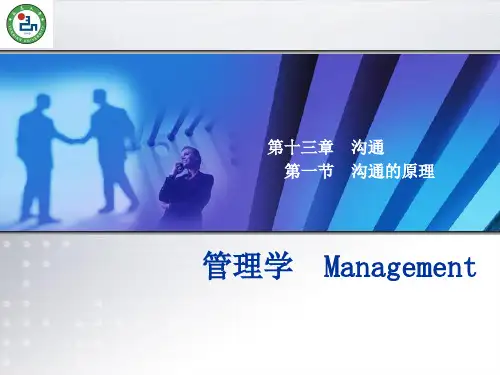
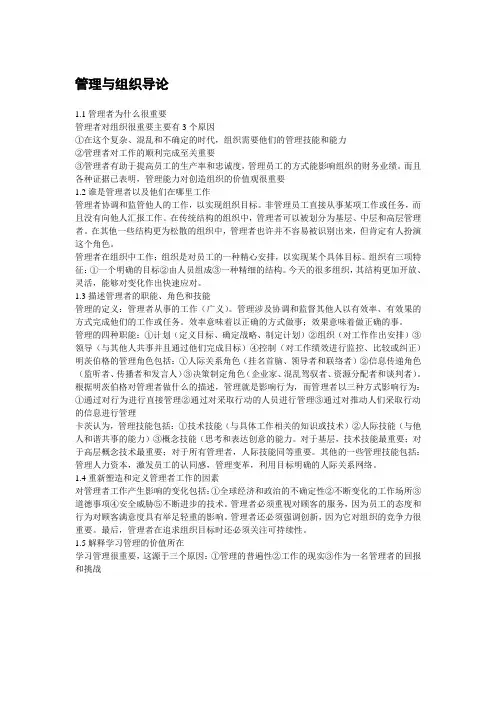
管理与组织导论1.1管理者为什么很重要管理者对组织很重要主要有3个原因①在这个复杂、混乱和不确定的时代,组织需要他们的管理技能和能力②管理者对工作的顺利完成至关重要③管理者有助于提高员工的生产率和忠诚度,管理员工的方式能影响组织的财务业绩。
而且各种证据已表明,管理能力对创造组织的价值观很重要1.2谁是管理者以及他们在哪里工作管理者协调和监管他人的工作,以实现组织目标。
非管理员工直接从事某项工作或任务,而且没有向他人汇报工作。
在传统结构的组织中,管理者可以被划分为基层、中层和高层管理者。
在其他一些结构更为松散的组织中,管理者也许并不容易被识别出来,但肯定有人扮演这个角色。
管理者在组织中工作;组织是对员工的一种精心安排,以实现某个具体目标。
组织有三项特征:①一个明确的目标②由人员组成③一种精细的结构。
今天的很多组织,其结构更加开放、灵活,能够对变化作出快速应对。
1.3描述管理者的职能、角色和技能管理的定义:管理者从事的工作(广义)。
管理涉及协调和监督其他人以有效率、有效果的方式完成他们的工作或任务。
效率意味着以正确的方式做事;效果意味着做正确的事。
管理的四种职能:①计划(定义目标、确定战略、制定计划)②组织(对工作作出安排)③领导(与其他人共事并且通过他们完成目标)④控制(对工作绩效进行监控、比较或纠正)明茨伯格的管理角色包括:①人际关系角色(挂名首脑、领导者和联络者)②信息传递角色(监听者、传播者和发言人)③决策制定角色(企业家、混乱驾驭者、资源分配者和谈判者)。
根据明茨伯格对管理者做什么的描述,管理就是影响行为,而管理者以三种方式影响行为:①通过对行为进行直接管理②通过对采取行动的人员进行管理③通过对推动人们采取行动的信息进行管理卡茨认为,管理技能包括:①技术技能(与具体工作相关的知识或技术)②人际技能(与他人和谐共事的能力)③概念技能(思考和表达创意的能力。
对于基层,技术技能最重要;对于高层概念技术最重要;对于所有管理者,人际技能同等重要。
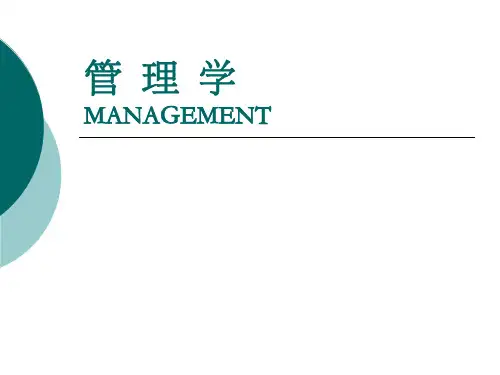
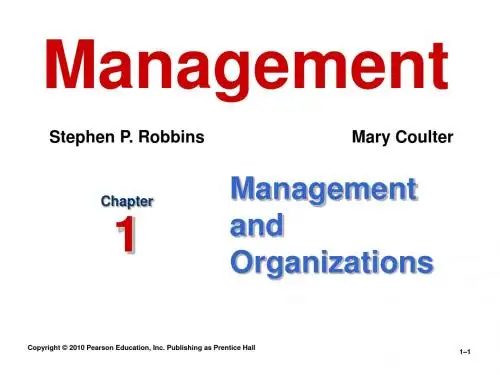
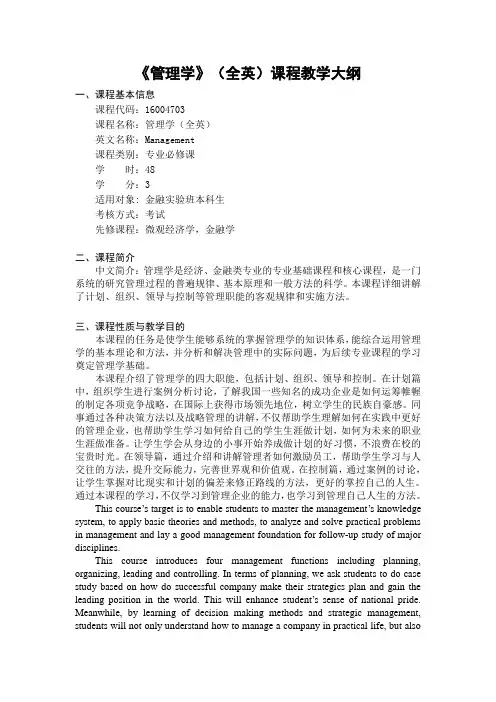
《管理学》(全英)课程教学大纲一、课程基本信息课程代码:16004703课程名称:管理学(全英)英文名称:Management课程类别:专业必修课学时:48学分:3适用对象: 金融实验班本科生考核方式:考试先修课程:微观经济学,金融学二、课程简介中文简介:管理学是经济、金融类专业的专业基础课程和核心课程,是一门系统的研究管理过程的普遍规律、基本原理和一般方法的科学。
本课程详细讲解了计划、组织、领导与控制等管理职能的客观规律和实施方法。
三、课程性质与教学目的本课程的任务是使学生能够系统的掌握管理学的知识体系,能综合运用管理学的基本理论和方法,并分析和解决管理中的实际问题,为后续专业课程的学习奠定管理学基础。
本课程介绍了管理学的四大职能,包括计划、组织、领导和控制。
在计划篇中,组织学生进行案例分析讨论,了解我国一些知名的成功企业是如何运筹帷幄的制定各项竞争战略,在国际上获得市场领先地位,树立学生的民族自豪感。
同事通过各种决策方法以及战略管理的讲解,不仅帮助学生理解如何在实践中更好的管理企业,也帮助学生学习如何给自己的学生生涯做计划,如何为未来的职业生涯做准备。
让学生学会从身边的小事开始养成做计划的好习惯,不浪费在校的宝贵时光。
在领导篇,通过介绍和讲解管理者如何激励员工,帮助学生学习与人交往的方法,提升交际能力,完善世界观和价值观。
在控制篇,通过案例的讨论,让学生掌握对比现实和计划的偏差来修正路线的方法,更好的掌控自己的人生。
通过本课程的学习,不仅学习到管理企业的能力,也学习到管理自己人生的方法。
This course’s target is to enable students to master the management’s knowledge system, to apply basic theories and methods, to analyze and solve practical problems in management and lay a good management foundation for follow-up study of major disciplines.This course introduces four management functions including planning, organizing, leading and controlling. In terms of planning, we ask students to do case study based on how do successful company make their strategics plan and gain the leading position in the world. This will enhance student’s sense of national pride. Meanwhile, by learning of decision making methods and strategic management, students will not only understand how to manage a company in practical life, but alsolearn how to make a plan for themselves in college and how to prepare themselves for their future career. We help students to start making plans from their daily life and not waster the treasure time in school. In terms of leading, by learning how to motivate employees, students learn how to communicate with other people. We help students to enhance their social skills and improve their world view and value view. In terms of controlling, by doing case study, students learn how to compare the reality to the plan and make adjustments in time to control their own life. By learning this course, students not only learning how to manage a company , but also learn how to manage their life.四、教学内容及要求Chapter 1Management and OrganizationsOverall Objective: the goal here is to know1. Understand why managers are important to organizations2. Understand who managers are and where they work3. Understand the functions, roles, and skills of managersContents:1. Why are Managers Important?2. Who Are Managers2.1 Classifying Managers2.2 Where Do Managers Work?3. What Do Managers Do?3.1 Effectiveness and Efficiency3.2 Management Functions3.3 Management Roles3.4 Skills Managers NeedPractice and Thinking:Do the homework on the textbook and review the “terms to know”.The homework for this chapter is to find your most appreciate Chinese manager and explain why you choose him or her. This homework conduct students to focus on Chinese companies and discover excellent Chinese managers. By learning the characteristic of these creative and brave managers, students want to be successful in the future more.Teaching Methods:Classroom lecture, multimedia teaching and case studyChapter 2 History of managementOverall Objective: the goal here is to know1. Understand some early management examples2. Understand the various theories in the classical approach3. Understand the development and uses of the behavioral approach4. Understand the quantitative approach5. Understand the various theories in the contemporary approachContents:1. Classical approach1.1 Scientific management1.2 General administrative theory2. Behavioral approach3. Quantitative approach4. Contemporary approach4.1 System theory4.2 Contingency approach5. Case studyPractice and Thinking:Do the homework on the textbook and review the “terms to know”.Teaching Methods:Classroom lecture, multimedia teaching and case studyChapter 3 Understand management context:constrains and challengesOverall Objective: the goal here is to know1. Understand the actions of managers according to the omnipotent and symbolic views2. Understand the constraints and challenges facing managers in today’s external environment3. Understand the characteristics and importance of organizational culture4. Understand current issues in organizational cultureContents:1. The Manager: Omnipotent or Symbolic?2. The External Environment: Constraints and Challenges2.1 The economic environment2.2 How the external environment affects managers2.3 Assessing environmental uncertainty3. What Is Organizational Culture?3.1 Benefits of a Strong Culture3.2 Where Does Culture Come From?3.3 How Do Employees Learn Culture?3.4 How Does Culture Affect Managers?Practice and Thinking:Do the homework on the textbook and review the “terms to know”.This chapter we discuss organizational culture and we use cases lika Alibaba, Huawei and Haier to show what kinds of obstacles a company might run into and how does the organizational curlture help the companies pass those difficult times. Though these case studies, students learn how to face and deal with dilemmas in their life with a positive and objective attitude.Teaching Methods:Classroom lecture, multimedia teaching and case studyChapter 7Managers as decision makersOverall Objective: the goal here is to know1. Understand the eight steps in the decision-making process2. Understand the four ways managers make decisions3. Understand decisions and decision-making conditions4. Understand different decision-making styles and discuss how biases affect decision making5. Understand effective decision-making techniquesContents:1. The Decision Making Process1.1 Identifying a Problem1.2 Identifying Decision Criteria1.3 Allocating Weights to the Criteria1.4 Developing Alternatives1.5 Analyzing Alternatives1.6 Selecting an Alternative1.7 Implementing the Alternative1.8 Evaluating Decision Effectiveness1.9 Scene simulation---- Survive in desert2. Different types of decision making2.1 Rational Decision-Making2.2 Bounded Rational Decision-Making2.3 Intuitive Decision-Making3. Types of decisions3.1 Programmed Decision3.2 Non-programmed Decision4. Decision-Making Situations4.1 Certainty4.2 Risk4.3 Decisions Under Uncertainty5 Decision-Making Styles6 Decision-Making Biases and ErrorsPractice and Thinking:Do the homework on the textbook and review the “terms to know”.Teaching Methods:Classroom lecture, multimedia teaching and case studyChapter 8 Foundations of PlanningOverall Objective: the goal here is to know1. Understand the nature and purpose of planning2. Understand the types of goals organizations might have and the plans they use3. Understand approaches to goal-setting and planning4. Understand contemporary issues in planningContents:1. What Is Planning?1.1 Why Do Managers Plan?1.2 Planning and Performance1.3 Elements of Planning2. Types of Goals3. Types of Plans3.1 Breath3.2 Time Frame3.3 Specificity3.4 Frequency of Use4. Goal-setting4.1 Traditional Goal Setting4.2 Management By Objectives4.3 Steps in Goal Setting5. Contingency Factors in Planning5.1 Manager’s level in the organization5.2 Degree of environmental uncertainty5.3 Length of future commitments6. Approaches to Planning7. Case StudyPractice and Thinking:Do the homework on the textbook and review the “terms to know”.Teaching Methods:Classroom lecture, multimedia teaching and case studyChapter 9 Strategic ManagementOverall Objective: the goal here is to know1. Understand strategic management and explain why it’s important2. Understand what managers do during the six steps of the strategic management process3. Understand the three types of corporate strategies4. Understand competitive advantage and the competitive strategies organizations use to get it5. Understand current strategic management issuesContents:1. What Is Strategic Management?2. Strategic Management Process2.1 Identifying the organization’s current mission, goals, and strategies2.2 Doing an external analysis2.3 Doing an internal analysis2.4 Formulating strategies2.5 Implementing strategies2.6 Evaluating results3. Corporate Strategies3.1 Growth strategy3.2 Stability strategy3.3 Renewal strategy3.4 BCG Matrix4. Competitive strategies4.1 Competitive advantage4.2 Five Forces ModelPractice and Thinking:Do the homework on the textbook and review the “terms to know”.This chapter we discuss case of Huawei. In 2019’s China-United States trade war, face the trade ban of chips, Huawei’s Haisi start to show itself and their domestically developed chips become useful. This shows that Huawei has taken precautions many yeas ago and has made a strategic plan to cope with the chip shortage in the future. By learning and discussing this case, we enhance students’ senses of national pride and ambitions to make contribution to the country.Teaching Methods:Classroom lecture, multimedia teaching and case studyChapter 10 Basic Organizational DesignOverall Objective: the goal here is to know1. Understand six key elements in organizational design2. Understand mechanistic and organic structures3. Understand the contingency factors that favor either the mechanistic model or the organic model of organizational design4. Understand traditional organizational designsContents:1. Designing Organizational Structure2. Organizational Design2.1 Work specialization2.2 Case study2.3 Departmentalization2.4 Chain of command2.5 Case study2.6 Span of control2.7 Case study2.8 Centralization and decentralization2.9 Case study2.10 Formalization3. Mechanistic Vs Organic Organization3.1 Mechanistic Organization3.2 Organic Organization4. Contingency Factors5. Some Organizational Designs5.1 Divisional structure5.2 Matrix Structure5.3 Project StructurePractice and Thinking:Do the homework on the textbook and review the “terms to know”.Teaching Methods:Classroom lecture, multimedia teaching and case studyChapter 16 Motivating EmployeesOverall Objective: the goal here is to know1. Understand motivation2. Understand early theories of motivation3. Understand contemporary theories of motivation4. Understand current issues in motivationContents:1. What is Motivation?1.1 Definition1.2 Case Study1.3 Motivation Process2. Early Theories of Motivation2.1 Maslow’s Hierarchy of Needs2.2 McGregor’s Theories X and Y2.3 Herzberg’s Two-Factor Theory2.4 McClelland’s Three Needs Theory3. Contemporary Theories of Motivation3.1 Reinforcement Theory3.2 Equity Theory3.3 Expectancy TheoryPractice and Thinking:Do the homework on the textbook and review the “terms to know”.This chapter we discuss Haidilao. Haidilao pays a lot of attentions on employee motivation. Besides regular material motivation, Haidilao gives great responsibilities to employees, so that the employees can act their potential creativeness and leading ability. And that’s one of the reason why Haidilao’s employee work with great passion and provide nice service to the customers. By discussing this case, students can understand that further cooperation and success is based on mutual respect of each other.Teaching Methods:Classroom lecture, multimedia teaching and case studyChapter 18 Introduction to ControllingOverall Objective: the goal here is to know1. Understand the nature and importance of control2. Understand the three steps in the control process3. Understand how organizational performance is measured4. Understand tools used to measure organizational performance5. Understand contemporary issues in controlContents:1. What Is Control?1.1 Why Is Control Important?2. What Do Managers Control?2.1 Performance control2.2 Financial control2.3 Operating control2.4 Information control2.5 Performance control3. Types of Control3.1 Feed forward control3.2 Concurrent control3.3 Feedback control3.4 Case Study 13.5 Case Study 24. The Control Process4.1. Case studyPractice and Thinking:Do the homework on the textbook and review the “terms to know”. Teaching Methods:Classroom lecture, multimedia teaching and case study五、各教学环节学时分配六、课程考核Grading Policy: Your grade for the course will be calculated as follows: Regular Homework and Class Participation 40%Final Exam 60%七、推荐教材和教学参考资源《Management》12th edition By Steven P. Robinson & Mary Coulter。

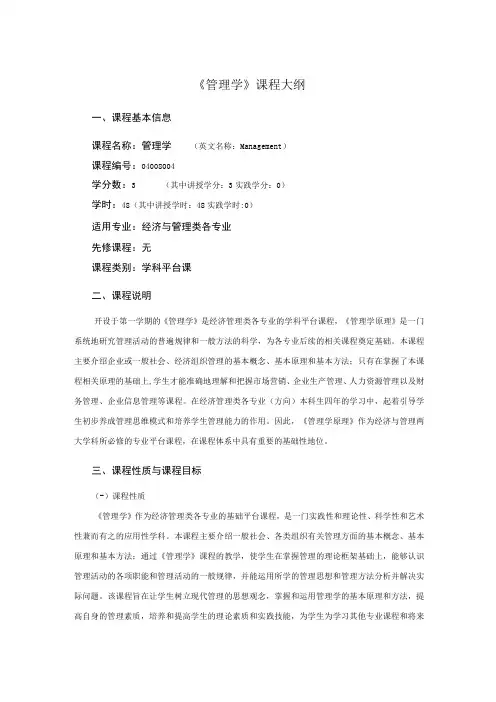
《管理学》课程大纲一、课程基本信息课程名称:管理学(英文名称:Management)课程编号:04008004学分数:3 (其中讲授学分:3实践学分:0)学时:48(其中讲授学时:48实践学时:0)适用专业:经济与管理类各专业先修课程:无课程类别:学科平台课二、课程说明开设于第一学期的《管理学》是经济管理类各专业的学科平台课程,《管理学原理》是一门系统地研究管理活动的普遍规律和一般方法的科学,为各专业后续的相关课程奠定基础。
本课程主要介绍企业或一般社会、经济组织管理的基本概念、基本原理和基本方法;只有在掌握了本课程相关原理的基础上,学生才能准确地理解和把握市场营销、企业生产管理、人力资源管理以及财务管理、企业信息管理等课程。
在经济管理类各专业(方向)本科生四年的学习中,起着引导学生初步养成管理思维模式和培养学生管理能力的作用。
因此,《管理学原理》作为经济与管理两大学科所必修的专业平台课程,在课程体系中具有重要的基础性地位。
三、课程性质与课程目标(-)课程性质《管理学》作为经济管理类各专业的基础平台课程,是一门实践性和理论性、科学性和艺术性兼而有之的应用性学科。
本课程主要介绍一般社会、各类组织有关管理方面的基本概念、基本原理和基本方法;通过《管理学》课程的教学,使学生在掌握管理的理论框架基础上,能够认识管理活动的各项职能和管理活动的一般规律,并能运用所学的管理思想和管理方法分析并解决实际问题。
该课程旨在让学生树立现代管理的思想观念,掌握和运用管理学的基本原理和方法,提高自身的管理素质,培养和提高学生的理论素质和实践技能,为学生为学习其他专业课程和将来就业打下坚实的理论基础和技能基础。
(二)课程目标通过课程学习,使学生对管理学能有一个全面的认知与了解,深入理解管理的主要职能,掌握管理学的基本理论、基本方法,并能初步应用于分析、解决具体管理问题,为进一步学习其他专业课程打下良好的基础;并能有意识地在自己的生活与学习中增进与外界的交往与沟通,培养自己的综合素养。
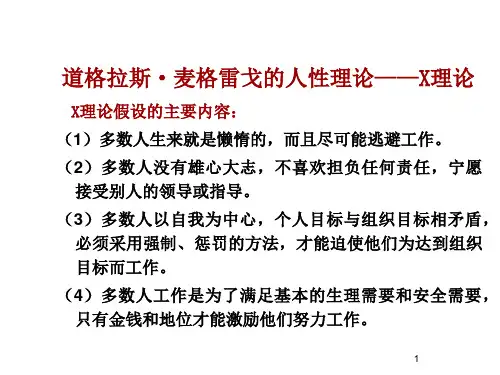

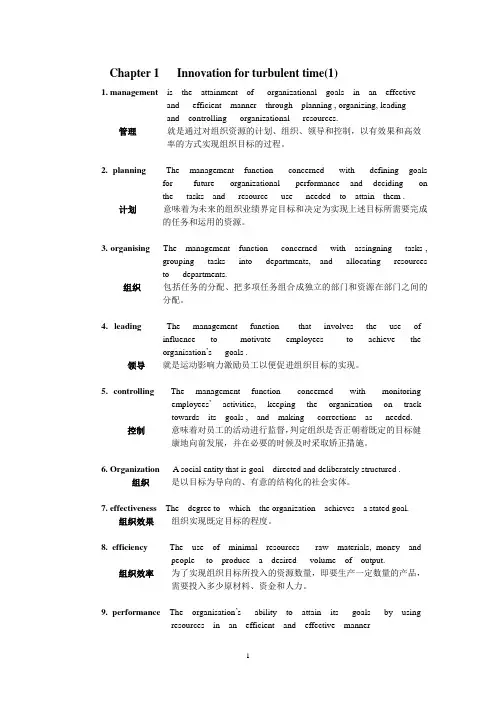
Chapter 1 Innovation for turbulent time(1)1. management is the attainment of organizational goals in an effectiveand efficient manner through planning , organizing, leadingand controlling organizational resources.管理就是通过对组织资源的计划、组织、领导和控制,以有效果和高效率的方式实现组织目标的过程。
2. planning The management function concerned with defining goalsfor future organizational performance and deciding onthe tasks and resource use needed to attain them .计划意味着为未来的组织业绩界定目标和决定为实现上述目标所需要完成的任务和运用的资源。
3. organising The management function concerned with assingning tasks ,grouping tasks into departments, and allocating resourcesto departments.组织包括任务的分配、把多项任务组合成独立的部门和资源在部门之间的分配。
4. leading The management function that involves the use ofinfluence to motivate employees to achieve theorganisation‟s goals .领导就是运动影响力激励员工以便促进组织目标的实现。
5. controlling The management function concerned with monitoringemployees‟activities, keeping the organization on tracktowards its goals , and making corrections as needed.控制意味着对员工的活动进行监督,判定组织是否正朝着既定的目标健康地向前发展,并在必要的时候及时采取矫正措施。
2014管理学终极无敌完美诠释版第1篇全球化管理的理论和实践基础名 1.管理管理是设计并保持一种良好环境,使人在群体里高效率地完成既定目标的过程。
1.作为管理人员,需完成计划、组织、人事、领导、控制等管理职能。
2.管理适用于任何一个组织机构。
3.管理适用于各级组织的管理人员。
4.所有管理人员都有一个共同的目标:创造盈余。
5.管理关系到生产率,意指效益和效率。
简19.泰罗科学管理的主要内容?1、工作定额原理2、能力与工作相适应原理3、标准化原理4、差别计件付酬制5、计划和执行相分离原理简7.泰罗科学管理的基本原则?(1)用科学(系统化的知识)代替凭经验的方法。
(2)在集体活动中取得协调一致以代替不一致。
(3)实现人们的彼此合作以代替混乱的个人主义。
(4)为最大的产出而劳动,而不是限制产出量。
(5)尽最大的可能培养工人,从而使他们自己和他们的公司都取得最大的成就。
简13. 科学管理理论的主要启示?(1)自觉把提高劳动生产率作为管理的中心问题。
(2共同的利益机制和相互间的思想感情的沟通。
(3时也要引进管理。
简8.简述霍桑实验的过程?(霍桑试验四阶段:)第一阶段照明试验(反响是负的)第二阶段继电器装配工人小组试验(结果又是负反响)第三阶段大规模访问面谈第四阶段接线板接线工作室试验简1.霍桑试验得出了什么结论?结论:生产效率不仅受物理的、生理的影响,而且受社会环境、社会心理的影响。
1,不能单纯依靠经济报酬来提高人们的积极性;2决定性作用;3重要作用;4影响。
第2篇计划名8.计划计划是对未来行动的预先安排,包括确定使命和目标以及完成使命和目标的行动;这需要制定决策,即从各种可供选择的方案中确定行动步骤。
涉及使命和目标的选择以及决定完成使命和目标的行动方案,即需要做出决策。
简9.编制计划的步骤?(一)认识到机会(二)确定目标(三)确定前提条件(四)拟定可供选择的方案(五)评估各种方案(六)选择方案(七)编制支持计划(分计划或派生计划)(八)编制预算,通过数字来大体反映整个计划简2.计划工作的四个原理是什么?1、限定因素原理(木桶原理)2、预约性原理(许诺原理)投入原理3、灵活性原理4、导向变化原理(改变航道原理)名21.德尔菲法是采用背对背的通信方式征询专家小组成员的预测意见,经过几轮征询,使专家小组的预测意见趋于集中,最后做出符合市场未来发展趋势的预测结论。
方案1:《管理学》 management管理是什么,主要讲了概论、管理者角色、计划、决策和目标管理第一部分基本概念管理是一个协调工作的活动过程,以便能有效率和效果地同别人一起,或通过别人一起实现组织目标的过程。
Management in all business and organizational activities is the act of getting people together to accomplish desired goals and objectives using available resources efficiently and effectively.1、管理的目的----实现组织目标。
goal--accomplish desired goals and objectives2、管理的核心----协调。
Core---Coordination3、管理的基础----组织。
Basis---organizing现代管理理论一般将管理职能分为4个:(1)计划 planning 计划包含的风险度;计划的主体是个人还是团队;管理者参与环境扫描程度。
(2)组织 organizing 员工拥有的自主权大小organizations have the autonomy of the size of the staff;;依个人还是团队完成任务;部门间的相互联系程度 The degree of interdepartmental linkages (3)领导leading 管理者对员工的关心程度 care staff ;管理者与员工的沟通程度the degree of communication between managers and employees;领导方式与风格选择leadership style(4)控制 controlling 员工自律与外控方式的选择control, staff discipline and external control mode choice;绩效评估标准的选择;Performance evaluation criteria selection 预防控制的使用prevention and control of the use.Management comprises planning, organizing, leading or directing, and controlling an organization (a group of one or more people or entities) or effort for the purpose of accomplishing a goal管理学---指研究管理活动的客观规律与方法的科学。
Syllabus for undergraduate of OUCCourse name:Principle of managementCourse time:48 class hoursCourse teacher:Dong Zhiwen1.Course OverviewPrinciple of management is a professional basic course of all kinds of management specialty. Following the six functions of management, this course includes basic functions, basic principles and basic methods of management. In addition, this course focuses on the systematic analysis and research of the practice of modern enterprise’management, it is an important basic course for students to learn other management courses.2.Student Learning OutcomesBy learning this course, the students can master the basic principle of management, basic theory, basic knowledge and basic skill. Moreover they are expected to master management skill to do the work such as decision-making, planning, organizing, leading, controlling and innovation. the students can broaden the train of thought, renew the idea, grasp the basic knowledge of management, and their ability to solve problems in practical economic activities can be improved.- 1 -3.Course Expectations(1) Come to class, listen carefully in class, participate in class discussion, in-class exercises and tests actively.(2) Finish homework on time.(3)Complete a certain amount of reading literature and background information.4.AssignmentsIn unit 3(planning) and unit 6(leading) teacher arranges practicing teaching. The students are required to find informant about project, make presentation and discuss case.5.Books To Purchase《Management: Principle and Methods》(6th edition),compiled by Zhou Sanduo, Chen Chuanming, Jia Dingliang, Fudan University publishing house, December 2014.6.Grading PolicyTest method is close-exam.Comprehensive evaluation system: the final grade consists of regular grades and final test scores. The regular grades are grading by their attendance and other behaviors in class, design for homework and so on. T- 1 -The regular grades accounts for 40 percent of the final grade and the final test scores accounts for 60 percent of the final grade.7.Course Calendar- 1 -。
管理学要点P5管理定义:管理是指组织为了达到个人无法实现的目标,通过各项职能活动,合理分配、协调相关资源的过程。
对定义的进一步解释:(1)管理的载体是组织。
(2)管理的本质是合理分配和协调各种资源的过程,而不是其他。
(3)管理的对象是相关资源,既包括人力资源在内的一切可以调用的资源。
(4)管理的职能活动包括信息、决策、计划、组织、领导、控制和创新。
(5)管理的目的是为了实现既定的目标。
P6管理者的角色:1.人际角色2.信息角色3.决策角色(亨利名茨伯格提出)P8管理者技能:1.技术技能2.人际技能3.概念技能(罗伯特卡茨提出)P13 泰罗:“科学管理之父”,1911年,他的著作《科学管理原理》标识管理作为一门科学诞生。
泰罗的科学管理理论主要包括以下几方面:(1)工作定额:要制定出有科学依据的工人的“合理的日工作量”,就必须进行时间和动作研究。
(2)标准化:要使工人掌握标准化的操作方法,使用标准化的工具、机器和材料,并使作业环境标准化,这就是所谓的标准化原理。
(3)能力与工作相适应:为了提高工作生产率,必须为工作挑选第一流的人工。
(4)差别计件工资制:所谓“差别计件工资制”是指计件工资率随完成定额的程度而上下浮动。
(5)计划职能与执行职能相分离:泰罗认为应该用科学的工作方法取代经验工作方法。
P15法约尔的贡献:1916,著作《工业管理与一般管理》;他的理论贡献主要体现在他对管理职能的划分和管理原则的归纳上。
(1)六种基本活动1技术活动,指生产、制造和加工2商业活动,指采购、销售和交换3财务活动,指资金的筹措、运用和控制4安全活动,指设备的维护和人员的保护5会计活动,指货物的盘点、成本统计和核算6管理活动,指计划、组织、指挥协调和控制。
(2)管理的14条原则:1分工2权力与责任3纪律4统一指挥5统一领导6个人利益服从集体利益7报酬合理8集权与分权9等级链与跳板10秩序11公平12人员稳定13首创精神14集体精神P17韦伯的贡献:提出了“理想的行政组织体系”理论,其特点是:(1)存在明确的分工。